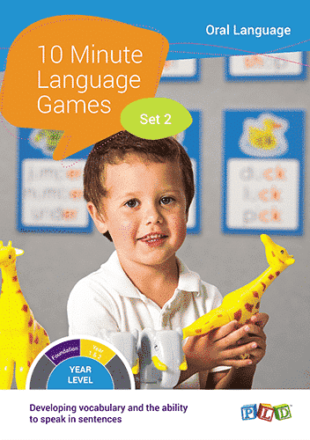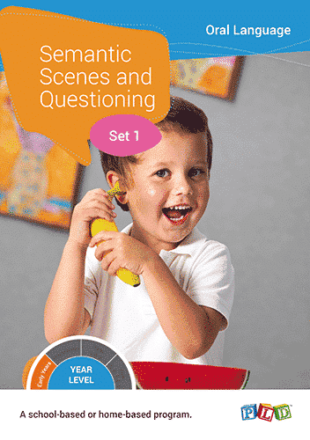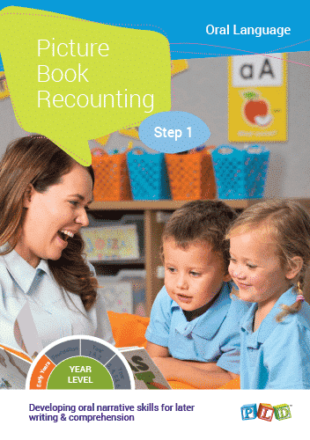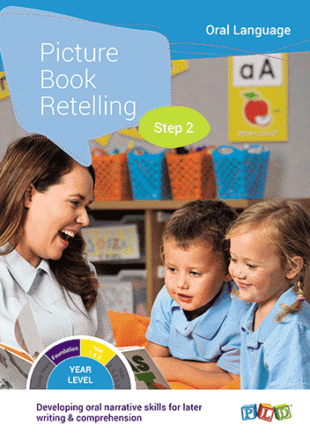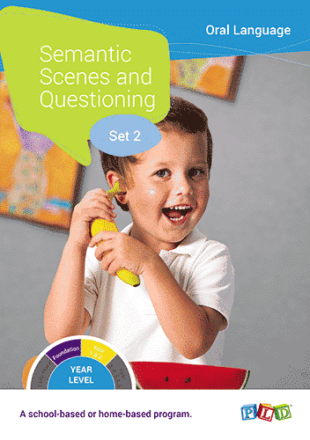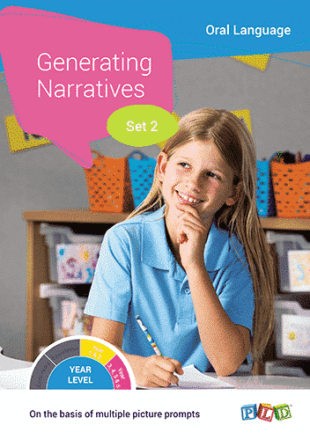School Licences
Showing 113–128 of 130 results
-
Phonic Dictation – Stage 2
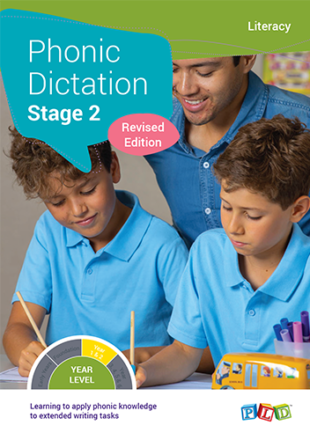
Applying Phonic Knowledge to Extended Writing Tasks
Phonic Dictation: Stage 2 supports students to bridge the gap between correctly spelling test words and applying their skills to extended writing. By completing regular dictation tasks, students rehearse and reinforce their phonics and spelling knowledge in increasingly complex contexts, improving their ability to transfer skills to self-generated writing. Dictation sessions are quick to prepare yet deliver significant benefits across key literacy areas, including: Listening and auditory memory Handwriting and language development Spelling application Program Includes: A4, spiral-bound book. Three levels of phonic passages: full-length passage format, ideal for Tier 1 students, and two shortened versions with reduced word counts for students requiring modifications. Phonic concepts: /sh/ /ch/ /th/ /oo/ /ee/ /ck/ /ar/ /or/ /ay/ /ai/ /oy/ /oi/ /er/ /ing/ Consonant clusters and double consonants. Long vowels: /a-e/ /e-e/ /i-e/ /o-e/ /u-e/ Phonic concepts: /oa/ and /ow/ (as oa), /ir/ (as er), /ur/ (as er), /er/ and /aw/ (as or) /or/, /ea/ (as ee) /ee/, /ou/ and /ow/ (as ou) etc. Additional passages covering concepts such as, prefixes, suffixes, high frequency words and homophones have been included in the APPENDIX section of the program. Other Programs within the Range: First Writing Activities (Foundation) Phonic Diction: Stage 1 Phonic Diction: Stage 2 Phonic Diction: Stage 3 Phonic Diction: Stage 4 Phonic Diction: Stage 5 Phonic Diction: Stage 6 Phonic Diction: Junior & Middle Primary Set (Stage 1, 2, 3, 4) Full Set of Phonic Diction Books (Discounted Bundle) Phonic Diction: Stage 1 Catch-Up (For Older Students) Phonic Diction: Stage 2 Catch-Up (For Older Students) Bulk Order Discounts 5-9 copies: 10% off 10+ copies: 15% off Links to the Teaching Sequence Manuals: This product can be used to support the implementation of the Year 1 and 2 Teaching Sequence Manual
$82.50$82.50 incl. GST[flipbook-popup id=''][/flipbook-popup] -
Phonic Dictation – Stage 3
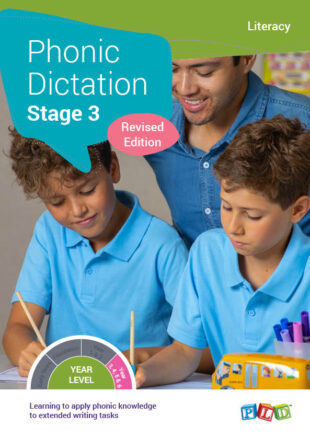
Applying Phonic Knowledge to Extended Writing Tasks
Phonic Dictation: Stage 3 supports students to bridge the gap between correctly spelling test words and applying their skills to extended writing. By completing regular dictation tasks, students rehearse and reinforce their phonics and spelling knowledge in increasingly complex contexts, improving their ability to transfer skills to self-generated writing. Dictation sessions are quick to prepare yet deliver significant benefits across key literacy areas, including: Listening and auditory memory Handwriting and language development Spelling application Program Includes: A4, spiral-bound book. Three levels of phonic passages: full-length passage format, ideal for Tier 1 students, and two shortened versions with reduced word counts for students requiring modifications. Revision of Phonic Dictation: Stage 2 phonic concepts to reinforce foundational knowledge. Phonemic spelling strategy and phonic concepts: /igh/ /-y/ /i-e/ /tch/ /dge/ /ge/ /ea/ as ('e'). Onset and rime spelling strategy and phonic concepts: /ace/ /ice/ /air/. Syllabic spelling strategy and phonic concepts: /ph/ /-ble/ /qu/ /be/. Additional passages covering concepts such as, prefixes, suffixes, high frequency words and homophones have been included in the APPENDIX section of the program. Other Programs within the Range: First Writing Activities (Foundation) Phonic Diction: Stage 1 Phonic Diction: Stage 2 Phonic Diction: Stage 3 Phonic Diction: Stage 4 Phonic Diction: Stage 5 Phonic Diction: Stage 6 Phonic Diction: Junior & Middle Primary Set (Stage 1, 2, 3, 4) Full Set of Phonic Diction Books (Discounted Bundle) Phonic Diction: Stage 1 Catch-Up (For Older Students) Phonic Diction: Stage 2 Catch-Up (For Older Students) Bulk Order Discounts 5-9 copies: 10% off 10+ copies: 15% off Links to the Teaching Sequence Manuals: This product can be used to support the implementation of the Year 3, 4, 5 and 6 Teaching Sequence Manual
$82.50$82.50 incl. GST[flipbook-popup id=''][/flipbook-popup] -
Phonic Dictation – Stage 4
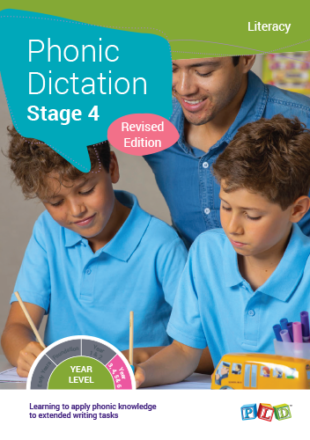
Applying Phonic Knowledge to Extended Writing Tasks
Phonic Dictation: Stage 4 supports students to bridge the gap between correctly spelling test words and applying their skills to extended writing. By completing regular dictation tasks, students rehearse and reinforce their phonics and spelling knowledge in increasingly complex contexts, improving their ability to transfer skills to self-generated writing. Dictation sessions are quick to prepare yet deliver significant benefits across key literacy areas, including: Listening and auditory memory Handwriting and language development Spelling application Program Includes: A4, spiral-bound book. Revision of Phonic Dictation: Stage 3 phonic concepts to reinforce foundational knowledge. Phonemic spelling strategy and phonic concepts: /ci/ as (sh) /y/ as (i) /tu/ as (ch) etc. Onset and rime spelling strategy and phonic concepts: /age/ /our/ /ain/. Syllabic spelling strategy and phonic concepts: /mid/ /fore-/ etc. Additional passages covering concepts such as, prefixes, suffixes, high frequency words and homophones have been included in the APPENDIX section of the program. Other Programs within the Range: First Writing Activities (Foundation) Phonic Diction: Stage 1 Phonic Diction: Stage 2 Phonic Diction: Stage 3 Phonic Diction: Stage 4 Phonic Diction: Stage 5 Phonic Diction: Stage 6 Phonic Diction: Junior & Middle Primary Set (Stage 1, 2, 3, 4) Full Set of Phonic Diction Books (Discounted Bundle) Phonic Diction: Stage 1 Catch-Up (For Older Students) Phonic Diction: Stage 2 Catch-Up (For Older Students) Bulk Order Discounts 5-9 copies: 10% off 10+ copies: 15% off Links to the Teaching Sequence Manuals: This product can be used to support the implementation of the Year 3, 4, 5 and 6 Teaching Sequence Manual
$82.50$82.50 incl. GST[flipbook-popup id=''][/flipbook-popup] -
Developing News Telling and Narrative Skills for 5 Year Olds
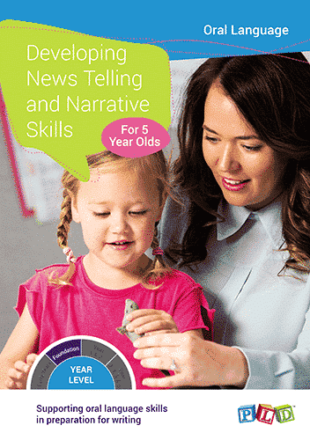
Developing News Telling and Narrative Skills is an instruction manual with explicit details on how to develop show and tell, activity retells and news telling for 5 year olds
As children enter school as five-year-olds they continue to make the steps that move them from conversations to literate language. This can be a daunting step for all involved but Developing News Telling and Narrative Skills is designed to make the journey easier. The strategies used in this book are linked to later developing narrative skills, just as pre-literacy skills are the foundation skills for spelling and reading development. It is critical that teachers and parents assist children in the development of language and narrative skills as they are a crucial component and predictor of later interpretative reading and writing success. Developing News Telling and Narrative Skills attempts to break down news and early narrative skills into simple sequential steps for teachers and parents to follow with children. The program trains parents and teachers to identify where children need to develop and strengthen their skills and presents specific techniques and supports to do so. The program provides simple activities and visual cues that are designed to be incorporated into classroom and home environments utilising activities that occur every day. The program provides: assessment and monitoring procedures planning and programming supports visual supports and activity ideas techniques and strategies to develop and accelerate language skills. News telling is a challenge for students and teachers, however, practice is the key and the more students are exposed to the language associated with telling news the more their expressive language will improve. The programs within the range include: Early Years Programs: Picture Book Retelling – Step 1 Developing News Telling and Narrative Skills for 4 Year Olds Foundation Programs: Picture Book Retelling – Step 2 Developing News Telling and Narrative Skills for 5 Year Olds Year 1 & 2 Program: Connecting Oral and Written Language – Step 1 Year 3, 4, 5 & 6 Program Connecting Oral and Written Language – Step 2 This resource is mentioned in the Foundation Teaching Sequence Manual on page 13.
$82.50$82.50 incl. GST[flipbook-popup id=''][/flipbook-popup] -
Connecting Oral and Written Language – Step 1
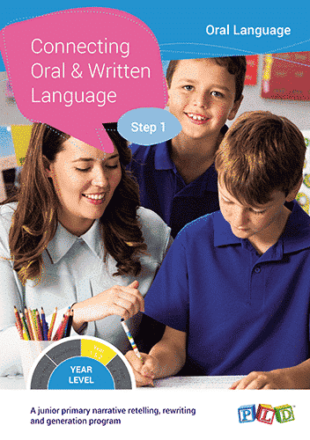
Instructional material outlining how to teach 6 to 8 year olds narrative oral retelling, rewriting and generation.
Although there are many types of genres, the most complex genre is narrative. The production of a narrative is more cognitively and linguistically demanding than participation in a conversation. Research repeatedly reports that narrative programs positively impact overall reading comprehension and written expression ability. Hence once skills are developed in this area, there is a flow on effect to all other forms of comprehension and written work. Within Connecting Oral and Written Language – Step 1 the initial oral stage is incredibly important. From a Speech Pathology perspective, oral expression ability is the precursor to written expression ability. Too often students are required to generate narratives before solid foundation skills are established. Remember students need to be provided with multiple opportunities to analyse and orally retell familiar narratives. In this way, they are rehearsing and practicing their oral language skills and simultaneously developing a solid understanding of narrative structure. Remember do not underestimate the value of the initial oral stages of narrative skills development. This program, designed by Speech Pathologists for 6 to 8 year olds features: Narrative tasks are presented in an order of ascending complexity (i.e. pre-narrative, oral narrative retells, written narrative retells and finally narrative generation). The manual outlines how to instruct 6 to 8 year old narrative ability and recommends over 45 suitable picture books. The classroom pack includes explicit narrative structure cards and display posters The programs within the range include: Early Years Programs: Picture Book Retelling – Step 1 Developing News Telling and Narrative Skills for 4 Year Olds Foundation Programs: Picture Book Retelling – Step 2 Developing News Telling and Narrative Skills for 5 Year Olds Year 1 & 2 Program: Connecting Oral and Written Language – Step 1 Year 3, 4, 5 & 6 Program Connecting Oral and Written Language – Step 2 This product is mentioned in the Year 1 & 2 Teaching Sequence Manual on page 20.
$82.50$82.50 incl. GST[flipbook-popup id=''][/flipbook-popup] -
Connecting Oral and Written Language – Step 2
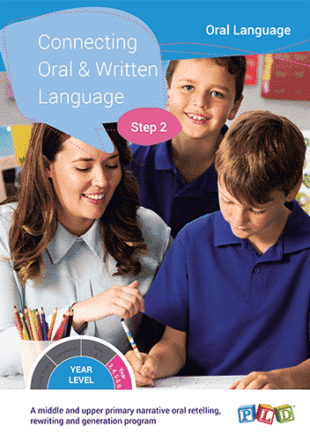
Connecting Oral & Written Language – Step 2 is an instructional material outlining how to teach 9 to 12 year olds to express themselves in a structured way
Although there are many types of genres, the most complex genre is narrative. The production of a narrative is more cognitively and linguistically demanding than participation in a conversation. Research repeatedly reports that narrative programs positively impact overall reading comprehension and written expression ability. Hence once skills are developed in this area, there is a flow on effect to all other forms of comprehension and written work. Within Connecting Oral and Written Language – Step 2 the initial oral stage is incredibly important. From a Speech Pathology perspective, oral expression ability is the precursor to written expression ability. Too often students are required to generate narratives before solid foundation skills are established. Remember students need to be provided with multiple opportunities to analyse and orally retell familiar narratives. In this way, they are rehearsing and practicing their oral language skills and simultaneously developing a solid understanding of narrative structure. Remember do not underestimate the value of the initial oral stages of narrative skills development. This program, designed by Speech Pathologists for 9 to 12 year olds features: Narrative tasks are presented in an order of ascending complexity (i.e. pre-narrative, oral narrative retells, written narrative retells and finally narrative generation). The manual outlines how to instruct 9 to 12 year olds narrative ability and recommends over 45 suitable picture books. The classroom pack includes explicit narrative structure cards and display posters The programs within the range include: Early Years Programs: Picture Book Retelling – Step 1 Developing News Telling and Narrative Skills for 4 Year Olds Foundation Programs: Picture Book Retelling – Step 2 Developing News Telling and Narrative Skills for 5 Year Olds Year 1 & 2 Program: Connecting Oral and Written Language – Step 1 Year 3, 4, 5 & 6 Program Connecting Oral and Written Language – Step 2
$82.50$82.50 incl. GST[flipbook-popup id=''][/flipbook-popup] -
Developing Cutting Skills – Step 1, 2 and 3
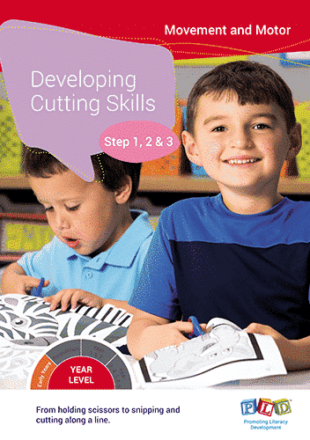
Developing Cutting Skills Step 1-3 is a program for 3 to 6 year-olds focused on developing scissor and cutting skills
Developing Cutting Skills (Stages 1-3) is one of a series of two books created by occupational therapists and teachers to support the development of cutting skills in children between the ages of 3 and 6 at school or home. The activities target specific skills that will enable children to develop the coordination and motor skills required for cutting. Multiple opportunities to rehearse cutting skills are provided through simple, easy-to-use worksheets with clear instructions. The series outlines developmental milestones that can be useful for planning, assessment and creating individual education plans. Developing cutting skills is part of a holistic approach to promoting a comprehensive foundation for academic success. From holding scissors to snipping and cutting along a line, this book features: Simple and easy to use, the resource targets scissor skills in early childhood and developmental manner Provides multiple opportunities to rehearse cutting skills Developmental milestone norms throughout the manual This product is mentioned in the Early Years Teaching Sequence Manual on page 10. There are two resources in this series: Developing Cutting Skills – Step 1, 2 & 3 Developing Cutting Skills – Stage 4
$82.50$82.50 incl. GST[flipbook-popup id=''][/flipbook-popup] -
10 Minute Language Games – Set 1
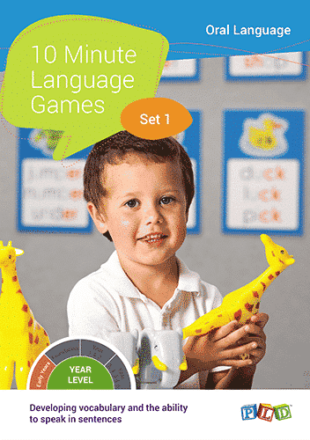
Developing vocabulary and the ability to speak in sentences.
Introduction to the Program This program is designed to provide quick, engaging activities that foster oral language development in young learners. Each game takes just 10 minutes, making it easy to incorporate into daily routines or classroom sessions. The Program Includes: 6 themes, each with 3 different language games Naming and speaking in single words Sorting and speaking in short sentences Describing and connecting several sentences together Vocabulary focused on real-life categories relevant to children Food Things you wear Farm animals Things that take you places Toys Around the home Activities tailored to 3-5 year old language development stages Other Programs within the Range: 10 Minute Language Games – Set 1 10 Minute Language Games – Set 2 Links to the Teaching Sequence Manuals This product is mentioned in the Early Years Teaching Sequence Manual
$82.50$82.50 incl. GST[flipbook-popup id=''][/flipbook-popup] -
10 Minute Language Games – Set 2
Developing vocabulary and the ability to speak in sentences.
Introduction to the Program This program is designed to provide quick, engaging activities that foster oral language development in young learners. Each game takes just 10 minutes, making it easy to incorporate into daily routines or classroom sessions. The Program Includes: 6 themes, each with 3 different language games Naming and speaking in single words Sorting and speaking in short sentences Describing and connecting several sentences together Vocabulary focused on real-life categories relevant to children Food Things you wear Farm animals Things that take you places Toys Around the home Activities tailored to 3-5 year old language development stages Other Programs within the Range: 10 Minute Language Games – Set 1 10 Minute Language Games – Set 2 Links to the Teaching Sequence Manuals This product is mentioned in the Early Years Teaching Sequence Manual
$82.50$82.50 incl. GST[flipbook-popup id=''][/flipbook-popup] -
Semantic Scenes and Questioning – Set 1
A school-based or home-based program designed to equip teachers and parents of 3-4 year old children with activities that will develop semantic knowledge.
Semantic Scenes and Questioning – Set 1 is designed to equip teachers and parents of 3-4 year old children with activities that will develop semantic knowledge. A good grasp of semantics broadens a child’s understanding of the meaning of words, which then helps them to understand what they hear or read and also helps them to express exactly what they want to say. A child who is struggling with semantics will be the child who: Can’t stay on the topic of simple story or news telling, but goes off on unrelated tangents. Takes a long time to think of particular words they want to use in conversation. Uses non specific vocabulary such as ‘that’ ‘there’ ‘this one’. Has difficulty sorting items into groups, describing them, and finding differences and similarities. Has difficulty understanding instructions that include time vocabulary such as ‘before’ ‘after’ ‘first’ etc. ‘Semantics’ refers to the meaning of sentences and words and how words relate to one another. That is, whether words belong in groups or categories together (e.g. Apples and oranges and pears are all fruit), whether they are similar to each other, or different and the features they have e.g. Size, shape and colour. Another way to think of semantics is like a network or web. Each word we speak or read has a place in this web. Each word has other words linked to it, some closely related and some distantly related. Each word belongs to several groups, some big and some small and each word has a definition that sets it apart from other words that are similar. Some words are related by the fact that they are actually opposites! All this information surrounding words is what we aim to teach young children about the vocabulary that is appropriate to their stage of development and life experience. Semantics is one facet of oral language. Given that oral language is not only a strong predictor of academic and social success but also a necessary requirement for good mental health, it is important that parents and teachers have the skills and resources needed to facilitate the development of oral language in young children. The aim of this program is to train parents and teachers to structure and facilitate developmentally appropriate semantic activities for 3 to 4 year old children. This program provides: Semantic activities and accompanying picture resources. Examples of appropriate and inadequate responses for 3-4 year old children. Techniques and strategies to implement when a child provides an inadequate answer. Features: Colour thematic picture scenes include the zoo, transport, at home, food, school, toys, Australian animals, clothes, under the sea and birthday party. Specific semantic questioning is outlined for each picture scene. Examples of appropriate and inadequate responses for 3-4 year old children. Techniques and strategies are outlined when a child provides an inadequate answer. This product is mentioned in the Early Years Teaching Sequence Manual on page 9. The programs within the range include: Semantic Scenes and Questioning – Set 1 Semantic Scenes and Questioning – Set 2
$82.50$82.50 incl. GST[flipbook-popup id=''][/flipbook-popup] -
Picture Book Recounting – Step 1
Developing oral narrative skills for later writing & comprehension.
Picture Book Retelling Step 1, is a teaching resource that attempts to break down early picture book retelling skills into simple sequential steps for teachers and parents to follow with their students and children. The program trains parents and teachers to identify where three and four year old students need to develop and strengthen their oral language skills and presents specific techniques and supports to do so. Ideal for Early Years and Pre-Primary students, Picture Book Retelling – Step 1 provides: Assessment and monitoring procedures Planning and programming supports Visual Supports Includes colour storytelling cards which assist early retelling efforts. Retell summaries for over 40 exciting and engaging picture books such as ‘Possum Magic’ By Mem Fox, ‘The Very Hungry Caterpillar’ By Eric Carle, ‘A sausage went for a walk’ By Elisha Marjid and many more! Techniques and strategies are outlined when a child provides poor retell of a story. Techniques and strategies to develop and accelerate language skills. Guidelines for structuring whole class, small group and individual activities. Comprehension questions. Retelling evaluation screen. Parent information sheets. Recommended books to read for Four Year Olds. A structured program designed by speech pathologists for teacher and parents. Storytelling can be a challenge for 3-4 year old students and teachers, however, practice is the key and the more students are exposed to the language associated with telling news or stories the more their expressive language will improve. This product is mentioned in the Early Years Teaching Sequence Manual on page 7. The programs within the range include: Early Years Programs: Picture Book Retelling – Step 1 Developing News Telling and Narrative Skills for 4 Year Olds Foundation Programs: Picture Book Retelling – Step 2 Developing News Telling and Narrative Skills for 5 Year Olds Year 1 & 2 Program: Connecting Oral and Written Language – Step 1 Year 3, 4, 5 & 6 Program Connecting Oral and Written Language – Step 2
$82.50$82.50 incl. GST[flipbook-popup id=''][/flipbook-popup] -
Picture Book Retelling – Step 2
Developing oral narrative skills for later writing & comprehension.
Picture Book Retelling Step 2, is a teaching resource that attempts to break down early picture book retelling skills into simple sequential steps for teachers and parents to follow with their students and children. The program trains parents and teachers to identify where 4 and seven year old students need to develop and strengthen their oral language skills and presents specific techniques and supports to do so. Ideal for Foundation, Year 1 and Year 2 students, Picture Book Retelling – Step 2 provides: Assessment and monitoring procedures. Planning and programming supports. Visual Supports. Includes colour storytelling cards which assist early retelling efforts. Retell summaries for over 40 exciting and engaging picture books such as ‘Possum Magic’ By Mem Fox, ‘The Very Hungry Caterpillar’ By Eric Carle, ‘A sausage went for a walk’ By Elisha Marjid and many more! Techniques and strategies are outlined when a child provides poor retell of a story. Techniques and strategies to develop and accelerate language skills. Guidelines for structuring whole class, small group and individual activities. Comprehension questions. Retelling evaluation screen. Parent information sheets. A structured program designed by speech pathologists for teacher and parents. Storytelling can be a challenge for 4-7 year old students and teachers, however, practice is the key and the more students are exposed to the language associated with telling news or stories the more their expressive language will improve. This product is mentioned in the Foundation Teaching Sequence Manual on page 13. The programs within the range include: Early Years Programs: Picture Book Retelling – Step 1 Developing News Telling and Narrative Skills for 4 Year Olds Foundation Programs: Picture Book Retelling – Step 2 Developing News Telling and Narrative Skills for 5 Year Olds Year 1 & 2 Program: Connecting Oral and Written Language – Step 1 Year 3, 4, 5 & 6 Program Connecting Oral and Written Language – Step 2
$82.50$82.50 incl. GST[flipbook-popup id=''][/flipbook-popup] -
Semantic Scenes and Questioning – Set 2
A school or home based program designed to equip teachers and parents of 5-6 year old children with activities that will develop semantic knowledge.
Semantic Scenes and Questioning – Set 2 is designed to equip teachers and parents of 5-6 year old children with activities that will develop semantic knowledge. A good grasp of semantics broadens a child’s understanding of the meaning of words, which then helps them to understand what they hear or read and also helps them to express exactly what they want to say. A child who is struggling with semantics will be the child who: Can’t stay on the topic of simple story or news telling, but goes off on unrelated tangents. Takes a long time to think of particular words they want to use in conversation. Uses non-specific vocabulary such as ‘that’ ‘there’ ‘this one’. Has difficulty sorting items into groups, describing them, and finding differences and similarities. Has difficulty understanding instructions that include time vocabulary such as ‘before’ ‘after’ ‘first’ etc. ‘Semantics’ refers to the meaning of sentences and words and how words relate to one another. That is, whether words belong in groups or categories together (e.g. Apples and oranges and pears are all fruit), whether they are similar to each other, or different and the features they have e.g. Size, shape and colour. Another way to think of semantics is like a network or web. Each word we speak or read has a place in this web. Each word has other words linked to it, some closely related and some distantly related. Each word belongs to several groups, some big and some small and each word has a definition that sets it apart from other words that are similar. Some words are related by the fact that they are actually opposites! All this information surrounding words is what we aim to teach young children about the vocabulary that is appropriate to their stage of development and life experience. Semantics is one facet of oral language. Given that oral language is not only a strong predictor of academic and social success but also a necessary requirement for good mental health, it is important that parents and teachers have the skills and resources needed to facilitate the development of oral language in young children. The aim of this program is to train parents and teachers to structure and facilitate developmentally appropriate semantic activities for 5 to 6 year old children. This program provides: Semantic activities and accompanying picture resources. Examples of appropriate and inadequate responses for 5-6 year old children. Techniques and strategies to implement when a child provides an inadequate answer. Features: Colour thematic picture scenes include the zoo, transport, at home, food, school, toys, Australian animals, clothes, under the sea and birthday party. Specific semantic questioning is outlined for each picture scene. Examples of appropriate and inadequate responses for 5-6 year old children. Techniques and strategies are outlined when a child provides an inadequate answer. This product is mentioned in the Foundation Teaching Sequence Manual on page 13 and the Year 1 & 2 Teaching Sequence Manual on page 20. The programs within the range include: Semantic Scenes and Questioning – Set 1 Semantic Scenes and Questioning – Set 2
$82.50$82.50 incl. GST[flipbook-popup id=''][/flipbook-popup] -
Phonic flash cards – Stage 1-4
Strengthening the relationship between letters and sounds
Flash cards are a powerful instructional tool, not only are they an effective way to present, practise, consolidate and revise concepts at a whole class, small group or individual student level, but they also cater for the range of ability that presents in any class. Within Phonic flash cards, a wide selection of phonic concepts have been included making it a practical and handy resource. For many classes, a proportion of students will present with advanced skills, a proportion will present with average or age-appropriate skills and a proportion will present with delayed skills. The students of greatest concern will be the students operating below the level of their peers. It is this group that will also require the greatest levels of on-going revision and consolidation. With this in mind, PLD have created Phonic Flash cards. One side of the flash cards are coloured and provide students with picture prompts. The other side lists the phonic concept without any supports. The resource also includes phonic concepts for the alphabet in stages 1-4. How can Phonic flash cards be used in the classroom? The traditional application, card flipping: The phonic concepts that have been covered in spelling lists can then be easily revised by collecting the associated phonic flash cards, hole punching the corners and placing them onto a metal ring. The specifically selected set of cards can be presented in an organised and time efficient manner. Mount the flash cards on the wall for display: The display of the cards on a classroom wall creates an attractive wall frieze and thereby a phonic reference point for the students to source when engaged in written tasks. Incorporate the flash cards into games: As a supplement to phonic-based spelling lists the flash cards can be incorporated into activities. This will help students be more curious and engaged in the task and thereby more likely to remember the concepts represented on the cards. Generous discounts apply for bulk orders 5 to 9 copies – 15% discount applies 10+ copies – 20% discount applies
$55.00$55.00 incl. GST[flipbook-popup id=''][/flipbook-popup] -
Phonic Bingo Games – Stage 1
Facilitating reading skill development through repeated practise.
At PLD, we believe the early attainment of decoding skill is important because this early skill accurately predicts later skills in the areas of word recognition and reading comprehension. Extensive research reports that children who get off to a slow start rarely become strong readers. Hence, students who learn to efficiently decode early will likely continue to improve in their reading ability. In comparison, the students that have poorly developed early decoding skills will tend to become increasingly distanced from the able readers. By embedding specifically levelled reading words within Phonic Bingo Games – Stage 1, students are provided with a motivating method of skill development. For the students who require repeated practice in order to master phonic decoding, the games allow for this rehearsal. The bright and engaging phonic-bingo games have been designed to target 11 levels of early reading words: Game 1: CVC words incorporating only 6 alphabet sounds. Game 2: CVC words incorporating basically half of the alphabet. Game 3: CVC words incorporating three-quarters of the alphabet. Game 4: CVC words incorporating the entire alphabet. Game 5: Words incorporating sh, ch and th. Game 6: Words incorporating oo, ee and ck. Game 7: CCVC words (i.e. incorporating initial consonant clusters). Game 8: CVCC words (i.e. incorporating final consonant clusters). Game 9: Words incorporating ar, or and er. Game 10: Words incorporating ai and ay. Game 11: Words incorporating oy and oi. It is hoped that your students enjoy their phonic-based game experience and that they benefit from strengthened decoding, word recognition, and spelling skills. As a versatile tool, the bingo games can be played over and over again with an adult or peers. Features: 11 bingo games (A5 size: 148.5mm high x 210mm wide). Instruction cards Bingo games incorporate CVC words introduced in four letter sound groups, Phonic themes: sh, ch, th; oo, ee, ck, CCVC words and CVCC words, Phonic themes: ar, or, er; ay, ai and oy, oi. This resource is mentioned in the Foundation Teaching Sequence Manual on page 11.
$55.00$55.00 incl. GST[flipbook-popup id=''][/flipbook-popup] -
Generating Narratives – Set 2
A resource for helping children to start expressing themselves verbally and in writing through the use of multiple picture prompts.
Generating Narratives: Set 2 supports Year 1 to 6 students develop verbal and written storytelling skills. Using picture prompts, this resource breaks narratives into three key components: An introduction to set the scene. A complication or problem. Characters' thoughts and feelings. This program is ideal for building students' confidence in both oral and written expression, whilst fostering creativity and a deeper understanding of story structure. Program Includes: A4 book: Spiral-bound, full colour and no preparation required. 10 Storylines & Picture Cards: each with three accompanying A4 Picture Cards illustrating narrative structure (30 cards in total). Included story themes: Escape from Prison Leaky Boat Storm Ruins Picnic The Fly Away Kite Soccer Grand Final Car Breakdown Hairdressing Disaster UFO House on Fire Shark Attack Narrative Structure Cards: includes 10 x A4 coloured narrative structure poster cards for display. Implementation: Picture cards guide students through introductions, complications and emotions, providing repeated practise in generating ideas and composing stories. Other Programs within the Range: Generating Narratives – Set 1 Links to the Teaching Sequence Manuals: This product can be used to support the implementation of the Year 1 and 2 Teaching Sequence Manual on Page 27 This product can be used to support the implementation of the Year 3, 4, 5, and 6 Teaching Sequence Manual on Page 34
$45.00$45.00 incl. GST[flipbook-popup id=''][/flipbook-popup]



